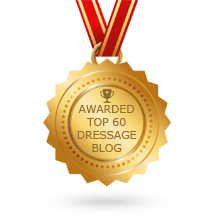|
There are currently some pictures circulating on the internet of the Spanish Riding School using rollkur. This is a particularly worrying move as the SRS has always been considered one of the most prestigious institutions of classical dressage. Today the word “flexion” is being used to redefine rollkur (as is “low, deep and round”) however, these “flexions” are not flexions according to the classical principles. True flexions are done without pulling and require a trainer with great tact and knowledge. The horse should turn through the neck and the nose should remain up or on the vertical, and when the horse softens his jaw, the rider’s hands soften. The horse’s head should never be pulled down to the chest, horizontal to the ground. With the pressure that needs to be applied to the bit for these deep flexions/rollkur, the horse can never soften his jaw.
Fexions were originally developed in the mid 1800s by Francois Baucher. He realized that tension in a horse was expressed by tension in the jaw, so developed a series of flexions to train the jaw to accept the bit softly. Baucher’s aim was to educate the horse to release the mouth to the slightest indication of the rider’s hand, resulting in relaxation of the muscles in the poll and neck. Baucher’s flexions are started from the ground and require great skill and feel on the part of the trainer so the horse understands what is being asked and does not become more resistant. Throughout Baucher’s descriptions of flexions he places great emphasis on the tact that the trainer needs to teach flexions correctly, and the damage that is caused by poorly trained flexion. Searching Google for rollkur pictures shows how unnatural and distressing it is for horses. Dressage should enhance a horse’s natural ability, and work only to develop the best each individual horse can produce, only then do you see the full beauty of the horse. No doubt the rollkur debate will continue, but as more people look for a different, more sympathetic way to train horses, classical dressage is more relevant today that ever. Make sure you check back in a fortnight for more classical dressage tips. In the mean time, you can visit me on my Facebook and Twitter accounts for more information about all things classical dressage © Training Riders, Transforming Horses For me, the ultimate goal of classical dressage is a light horse, which is a joy to ride, maneuverable and responsive with a back that carries you, giving you the quarters so you can direct the energy. Balance is key to creating lightness and is interlinked with suppleness. The starting point of all classical dressage training should be to build suppleness and balance both laterally and longitudinally. It is not possible to collect a horse that is not supple, collection requires the hind legs to flex through all the joints or the leg moves straight and the energy is pushed to the shoulder. This puts weight in the reins and prevents lightness. Horses start unbalanced, with weight in the shoulder, but with careful work on circles and in shoulder-in, you can start to build the suppleness and balance needed to develop a straight horse. Due to this link between suppleness and balance, your horse will not be straight until a basic level of balance and suppleness has been achieved. To begin working on suppleness and balance, start working on a circle and encourage inside bend through your position. The inside leg is softly used against the horse’s side so that he gives round the leg. It may help to bring the inside seat bone slightly forward to keep your seat balanced. This bending of the horse’s body will stretch the outside and strengthen the inside. To balance the action of your leg, bring your outside shoulder forward. Don’t bring the inside rein back as this will block the inside hind from coming through. Do let me know how you get on with the above exercise and make sure you check back next week for more classical dressage tips and training. In the meantime, you can visit me on my Facebook and Twitter accounts for more information about all things classical dressage. © Training Riders, Transforming Horses
|
AuthorDiane Followell Classical Dressage Trainer 
|
Telephone+44 (0)7931551014
|
|
© Diane Followell 2015 -2024.
All Rights Reserved.
All images and content are copyright Diane Followell unless otherwise stated.
All Rights Reserved.
All images and content are copyright Diane Followell unless otherwise stated.

 RSS Feed
RSS Feed

